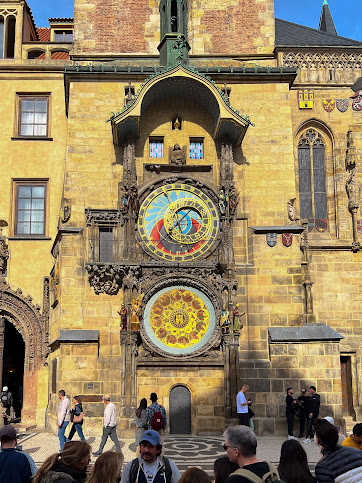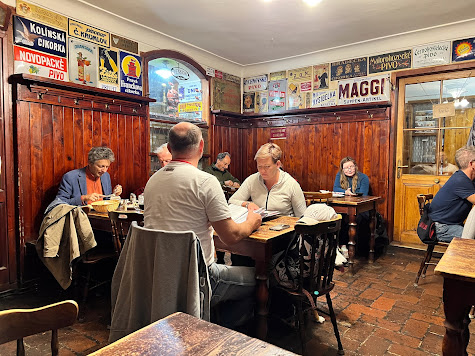During our Alaska trip, before we traveled to the Czech Republic, we encountered a wildlife specialist who told us about a Bohemian and Polish hunter that went missing in the wilderness. The rescue team eventually found some remains and it appeared they were attacked and devoured by a couple of grizzly bears. The team tracked the suspected bears and killed a male and female. To confirm they had the right culprits they cut open the female and identified the Polish hunter's remains. The specialist then reported: that means "The Czech is in the male"... Badda Bing, Badda Boom. Dad joke.
I grew up in a very German household in Chicago, a city defined by its immigrant neighborhoods, where ethnic jokes were the lingua franca. Not very PC or woke today but at the time we didn't consider the jokes discriminatory because post WW II they included everyone told by everyone - Brits, Irish, German, Poles, French, Scandinavians, Italian, and many others.
My parents were both first generation and spoke German around us kids when they wanted confidentiality. My father's parents emigrated from the Austria/Hungary Empire prior to WW I. My mother claimed to be a mix of Austrian and what she referred to as Bohemian. I only knew of Bohemia as a source of jokes, or the 50s beatnik lifestyle. (It was also the inspiration for the nineteenth century opera La Boheme and the twentieth century musical redux Rent.) Being only aware of the ethnic denigration, as a six year old I took a butter knife and said to my mother, "what part of me is Bohemian and I'll cut it out". It got the laugh I expected. The "Political Act" of travel is learning more about a culture and people and disabusing oneself of the tropes and stereotypes, or at least putting those stereotypes into richer context.
The Czech Republic is divided into three historic Duchies: Bohemia, Moravia, and Silesia. These all sounded familiar to me as my dad had a fascination with the region's history.
Our trip started in Prague, the capital of the country and of Bohemia. All our kids, and many friends, had been before us and were surprised that we'd never been. Understandable, the city is quite a travel destination. We stayed in the Hastal Hotel just north of Old Town Square. Originally built as a brewery in 1850 it was repurposed in 1912 as two apartments. Later, one apartment was converted to an Art Nouveau hotel. It has seen such Czech luminaries as Alphonse Mucha and Franz Kafka as well as famous visitors including Albert Einstein. It was taken over by the communist government in 1958, and it was Russia's HQ for central command during their invasion of Czechoslovakia. This was a slice of the old world still owned and run by the descendants of the original hotel owner.
In the center of the Old Town Square is a Memorial to Jan Hus, whom I'd never heard of, but is important to the history of Czech Rep and Christianity. One hundred years before Martin Luther, Jan Hus criticized the Catholic church for the extreme wealth of the clergy, selling indulgences, and ignoring the needs of the poor. He sought to have them return to righteousness. Instead the church convicted him of being a heretic and burned him at the stake. They spread his ashes on the Rhine so there'd be no grave for followers to venerate. It backfired and formed one of the first splits from the church before Lutherans - the Hussites. This rebellious streak, distrust of the Church, and communism's religious repression, the Czech population evolved to be among the most secular of all European nations.
Besides the beautiful and ornate Town Square, riverfront, and castle we enjoyed the civic art and of course Pilsner Beer (Pilsen is a town not far from Prague).
Bohemia also figures prominently in WWII. Sudetenland in SW Bohemia was a German enclave. Much as Putin today is using the excuse of ethnic Russians in the Donbas for invading Ukraine in 2014, Hitler used uniting German people as his excuse to invade Czechoslovakia in 1938. The German people of the region embraced the invasion. Understandably, but sadly, after the war, all Germans were forced to leave Czechoslovakia in an ethnic cleansing of traitors to the Slavic people.
We also took a day trip by bus to Terezin. It was originally a fortress under Austria Hungry, then became a prison. It most famous prisoner was Gavrilo Princip who assassinated Archduke Ferdinand in Sarajevo to start WW I.
However, in WWII it was a concentration camp. Though many died here, mostly Jews from Germany, Austria, and Scandinavia, it was primarily a transfer station to extermination camps in Poland. Besides Hitler, the person most responsible for the holocaust was Reinhard Heydrich, the German acting governor of the
While Terezin was very sobering and sad, we had a surprising and delightful encounter on leaving. While waiting for a bus back to Prague, another couple joined us at the stop. Like us, they were attired in travel clothes; lightweight pants, trainers, sun hat, and wind breakers, with a Rick Steves guidebook. They were from the other Washington on the East Coast. After some discussion we discovered a common interest in the small hamlet Stanley, ID (go figure) where they have a vacation house. On asking the woman what she did she modestly replied she works for the US government. Further probing she eventually revealed she is the US Ambassador to a well known middle east country. (She is a career Foreign Service officer, not a political appointee.) On the bus ride back we decided to have dinner together. While "the boys" were walking ahead I found out he is a retired Commander of the Navy. Truly a power couple. We had a delightful dinner together and hope to keep in touch.
We left Prague after three days for an anti-clockwise drive of the country through Bohemia and then Moravia (Part 2) before returning to Prague. Our first stop was Cesky Krumlov a charming town on the Vltava river. Traveling in October it was a beautiful fall visit, but we were told most of the people who used to live there now rent out their houses for AirBnb. In summer it's overrun with tourists and expensive.
Our next night was in the small village of Telc. On the way there we visited Trebon; and after Trebic. Trebic has a UNESCO site of an intact historic Jewish Ghetto.
Part 2 will continue our drive in Moravia east to the foothills of the Carpathian Mountains before heading back to Prague.


















No comments:
Post a Comment